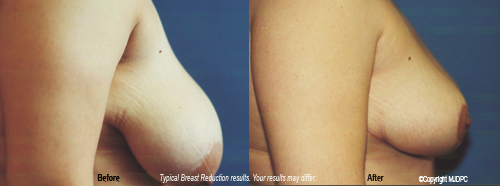Excessively large, sagging breasts can be uncomfortable, unhealthy and distracting from a woman's appearance. Large breasts can also restrict certain activities. Breast reduction surgery is performed by our doctor for patients in our region to reduce overdeveloped breasts and alleviate back pain, shoulder strap furrows, hand numbness and breathing difficulty.

What about getting pregnant and nursing after breast reduction surgery?
If you are considering having children, you should discuss this with your surgeon during your consultation. The ability to nurse after you have had the size of your breasts reduced is unpredictable. Should you decide to nurse after your surgery, you probably will experience some temporary engorgement.

What about mammograms after breast reduction surgery?
The risk of developing breast cancer seems to remain unchanged following a breast reduction, as do our recommendations for cancer screenings. Self breast examination should be performed monthly. A new baseline mammogram should be performed one year after your surgery. Your doctor will make further recommendations during your consultation.
Who are the best candidates for breast reduction?
The best candidates are women with very large breasts who require physical relief. Other candidates for breast reduction include those patients with one breast significantly larger than the other. Those with indentations in their shoulders from tight bra straps and those who are self-conscious or dissatisfied with their oversized breasts are also excellent candidates.
How is the breast reduction procedure performed?
Traditional breast reduction surgery is an outpatient procedure, but is sometimes performed as an inpatient procedure under general anesthesia, and takes between 2 - 4 hours. There are many variations to the procedure. The most common procedure involves an incision that circles the areola and extends downward following the curve of the crease beneath the breast. Your surgeon removes the excess glandular and fatty tissue. Then the nipple and areola are moved to their new position. The skin is then drawn together and down around the areola, providing a new shape to your breast. Unless your breasts are very large and pendulous, the nipples will likely remain attached. All incisions are closed with stitches.
Breast liposuction is a safe alternative to traditional breast reduction surgery. It may be performed with twilight sleep anesthesia combined with local anesthesia. Since the female breast is about 50% fat, a 1 - 3 cup reduction in size can be obtained using liposuction alone. Liposuction of the breast enables the surgeon to remove fatty tissue, but not glandular tissue. With this procedure, most patients experience a quicker recovery time with minimal scarring as compared to a traditional breast reduction. Depending on your breast size, breast liposuction might be an option to consider.
How will I feel after breast reduction surgery?
After our physician performs a traditional breast reduction procedure, the recovery can be extensive. Following your surgery, it is a good idea to sleep on your back to avoid undue pressure on your breasts. Sexual activity should be avoided for 1 - 2 weeks following surgery, and you should avoid strenuous activity for several weeks. It may be possible to return to work in 1 - 2 weeks. The stitches will be removed over the next few weeks. Bruising and swelling may take up to 6 weeks to disappear, and it may take up to a year or two for the scars to flatten and fade.
In contrast, patients undergoing breast liposuction are encouraged to resume normal activities as soon as they feel up to it. The scar is small and hidden, out of sight under the breast fold. The results of breast reduction surgery are permanent, but breast size may change due to weight gain or pregnancy.
Your new figure after breast reduction surgery
A breast reduction can make a dramatic change in your appearance and your outlook. A breast reduction can make your breasts smaller and firmer. Many patients find a new enjoyment in sports, exercise, dancing, or even just walking.